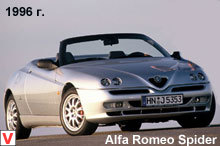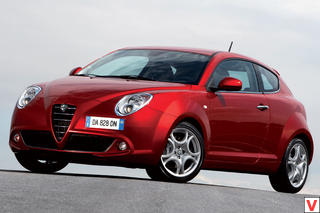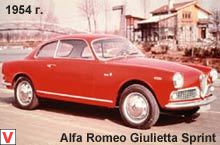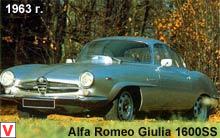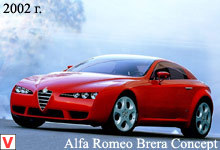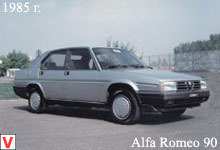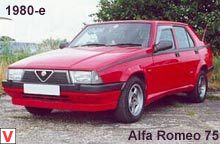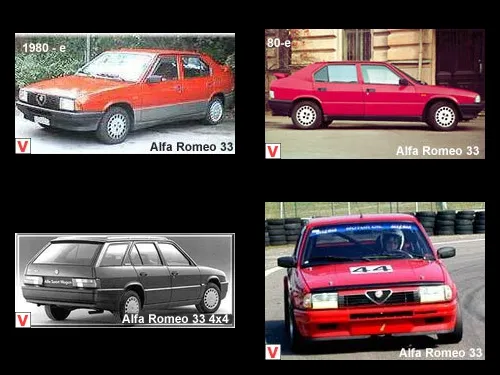
Alfa Romeo 33. In May 1983, the rather successful “Southern Alpha” - Alfasud and the disastrous Italo-Japanese Arna, were replaced by the new Alfa Romeo liftback - Alfa 33. The new model got its name in honor of Tipo 33, the pride of Alfa Romeo, champion world of the 70s. In August 1983, began mass production of new items. The mechanical part of the 33rd initially remained almost identical to Alfasud (instead of disc brakes, there were drum drums at the back), the difference was mainly in the bodywork. Like Alfasud, Alfa 33 was fully assembled at the Pomilano dʻArco plant.
Along with the 33rd, continued production of the Sprint coupe based on Alfasud, with 1286 (75 hp) and 1490 (84 hp) engines, the production of which was started in 1976. In general, in the history of development of the 33rd, there are three main periods - 1983-1985, 1985-1990, 1990-1994. Since the start of production, the Alfa 33 was equipped with 1.2, 1.3 (79hp), 1.5 (85hp) engines with single and dual carburetor power systems.

At the end of 1983 - the beginning of 1984, the Alfa 33 versions come out with engines of 85 and 95 hp. and all-wheel drive version - 1.5 4x4. At first, the cars were painted only in three colors: red, silver and dark gray "metallic". A year later, the five-door wagon Giardinetta and the all-wheel drive version with a forced drive on the SW rear axle (Sportwagon) went into the series, and in 1985 the family headed the modification Alfa 33 Quad-rifoglio Verde (QV) (abbreviated from the Italian quadrifoglio verde, "green maple sheet ") with a 1.5-liter 105-horsepower engine with two carburetors. Since 1985, the mechanical complex Sprint coupe has become completely identical to the Alfa 33.
Available in 2 versions - Sprint 1350 with an engine of 1350 cm3 (85 hp) and Sprint 1500 QV with an engine of 1490 cm3 (105 hp). In August of the same year, a limited edition, comes the version of the coupe Sprint Grand Prix, created on the basis of the 1.5 liter version, characterized by side protective covers in body color, headlight washers and the inscription Grand Prix. In April 1986, the next version 33 1.3S was released, equipped with an engine of 86 hp (instead of 79). In addition, its basic equipment included tinted windows and front power windows.
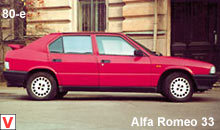
In the autumn of 1986, the car was modernized, and one of the first in the world appeared white turn signals, which will become fashionable only at the turn of the nineties. The interior has changed a little, for example, an extravagant system for adjusting the steering column in height, following the steering wheel, moving the entire dashboard, gave way to more simple and common. The top line of the hierarchy was taken by the new version 1.7 QV with a 117-horsepower engine and with a catalyst that was equipped with both a 2-carburetor power system and a Bosch Motronic injection system, and the list of power units was added to the VM Motori three-cylinder turbodiesel.
Among the cars of the second series of all-wheel drive modifications were no longer. In November of the same year, another upgraded version of the 1.5 engine is released. The previous QV in 1987 on the occasion was renamed 1.5 Ti (105 hp). From the other "thirty-third" of that period, except for 1.7 QV (114 hp), it is distinguished by a brand rear wing, an aerodynamic skirt along the rapids and a regular right mirror.

Also this year there are modernized versions 33 4x4- 105 hp, 33 break (SW) - 1.5 105 hp In October 1987, they released special versions 1.3 S and 1.5Ti - Alfa 33 Veloce, featuring improved exterior and interior trim (rear spoiler, right rear-view mirror, fog lights, side and bottom body ornaments, car-colored bumpers). With the exception of version 4x4, all versions of the 33rd edition of 1986-87 had different ratios in the transaxle and main gear. In July 1988, the new engine comes out - 1.7ie - 4-cylinder boxer, with a working volume of 1712 cm3, 110 hp, equipped with a new Bosch Jetronic LE 3 1 injection system with a digital ignition Bosch EZ 10.
Carburetor version 1.7 with From this moment they begin to equip valves with hydropushers. In 1988, 1.5 SL, 1.5Veloce, 1.5 QV and 1.5 break (SW) and the Sprint 1.5 QV coupe were removed from production. In mass production launched version of the coupe Sprint 1. 5 Grand Prix and the new Sprint 1.7 QV coupe series with a 1712 cm3 engine - 118 hp (max speed 200 km / h) (with a rear spoiler, alloy wheels and fog lights). In July 1989, new versions of the Alfa 33 SW and Alfa 33 SW 1.7 QV came out with a new 1.7ie engine. In 1989, the Sprint 1.5 coupe version was removed from the conveyor. Sprint 1.3 and Sprint and 1.7 QV remain in production, from the coupe model range.

Cosmetic changes were made on all models of the 33rd in 1989 - the front grille began to be painted in car colors, a new inscription on the rear door appeared, tinted windows were included in the standard equipment. In addition, the shape of the combustion chamber and the shape of the bottom of the piston have been changed — the RON 95 unleaded gasoline was used to operate the engine. In the same period, the 33rd flagship model appeared on the market, a real masterpiece with a 1.7 16v engine, 133 hp (129 with a catalyst) in versions 16v and 16 QV. Ruoteclassiche magazine called this car a “classic of tomorrow”, thus putting it on par with the legendary Giulia and Giulietta.
In November 1990, the Alfa 33 was restyled. The changes affected the body first, the taillights stretched out into a narrow strip, resulting in the 33rd reminded of Alfa 164. The power steering and fuel injection system were included in the standard equipment. At the same time she debuted the most powerful version of the 16V QV with a 16-valve engine with a capacity of 132 liters. with., which the Italian press instantly referred to the "living classics." Soon there was a revival of all-wheel drive modifications, called P4, and then it was the turn of replacing the carburetors with electronic fuel injection systems.
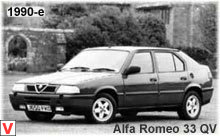
The diesel version of the 33rd was also produced for some time - with a 3-cylinder VM turbodiesel with a capacity of 1799 cm3. In September 1991, another all-wheel drive version of the Alfa 33, the Permanent 4, was released (renamed Q4 since May 1992). In the period from late 1990 to 1991, the engines 1.7 and 1.7 16v were equipped with catalytic converters. Imola, Feeling and Hit versions are released shortly before being discontinued.
Imola was equipped with a 1351 cm3 engine and a body version 33 16v QV (sport spoilers, aerodynamic exterior trim, Recaro seats, light alloy wheels) and a slightly modified suspension. Feeling and Hit were also equipped with a 1351 cm3 engine, but had a slightly different interior trim. In 1994, when the Alfa 33 was still on the line, it was replaced by a new model - the Alfa 145, and soon the Alfa 146, equipped with the same engines as the 33rd, except for a slightly modified 1.7 16v. At the same time, SportWagon is removed from production and for a long period Alfists lose a roomy family car with sports data.
Alfa 33 is a reliable, powerful, high-speed engine in an original and elegant body.
